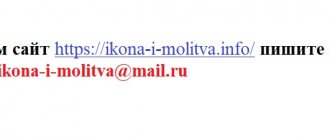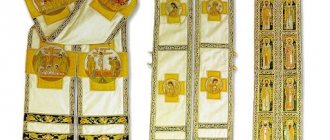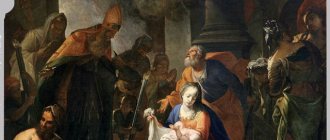The currently popular writer Lyudmila Ulitskaya in her novel “Daniel Stein, Translator” says: “Behaving with dignity and correctly is more important than observing rituals.” She is not alone in this; many people believe that behaving ethically is more important than observing church rituals or adhering to the opinion shared by the Orthodox Church.
In this case, such cornerstones of faith as the recognition of Jesus Christ as the Messiah, the ideas of the Trinity, Atonement and Salvation, etc. are called into question. To prevent this from happening and to prevent the strength of the Christian faith from being questioned, the Church developed and approved special provisions (dogmas) that are not subject to discussion or doubt.
The doctrine of dogmas was developed by ancient scientists and the Fathers of the Church
The history of the word “dogma” comes from ancient literature, but at that time it was not used in the theological sense. Thus, Cicero used the word dogma to designate those well-known doctrines that had the meaning of undeniable truth.
In the same sense, such Christian writers as Origen and Saint Isidore called Socrates the legislator of Attic dogmas, and the teachings of Plato and the Stoics - dogmas. According to Xenophon, dogma is an order of command to which everyone, both commanders and ordinary soldiers, must unquestioningly obey
Xenophon. Bust. The word “dogma” is already found in ancient authors, who define it as an administrative order that should be obeyed without discussion.
The interpretation of the concept of “dogma” from ancient literature migrated to Christian literature. Thus, in the Greek translation of 70 interpreters in the books of the prophet Daniel, Esther, and the books of Maccabees, the word δόγμα is called a royal decree, subject to immediate execution.
In addition, this word also refers to the royal or state law, which is unconditionally binding on every subject.
The word “dogma” is found in the translation of 70 interpreters in the books of the prophet Daniel.
In the New Testament, namely in the Gospel of Luke, the word δόγμα is used to describe Caesar’s order to take a census of the population of the Roman Empire. In the Book of Acts of the Apostles - the royal laws in the epistle to the Collossians and Ephesians - the laws of Moses, which had divine authority.
If we talk about religious dogmas, then first in the book of the Acts of the Apostles, and then in the book of Acts (XV, 20-28) this word denotes those definitions of the church that should have indisputable authority for each of its members.
Hieromartyr Ignatius the God-Bearer of Antioch. Saint Ignatius, together with other Church Fathers, developed in detail the concept of Christian dogma
Such Fathers of the Church as Ignatius the God-Bearer, Cyril of Jerusalem, John Chrysostom, etc. developed the concept of dogma in more detail. According to their writings:
- Dogma is an indisputable divine truth that is given through Divine Revelation. That is why the dogmas of God’s faith are not recognized as a product of speculative human thinking and personal opinion.
- Dogma is the truth that relates to the theory and essence of religion. This differs from the rules of everyday life for a Christian.
- Dogma, as a truth of divine origin, defined and formulated by the Church, is called dogmas of the Church (τά τής έκκλησίας δόγματα), or church dogmas (τά έκκλεσιαστικά δόγματα).
- A dogma is a truth that a Christian must unconditionally acknowledge in order to consider himself a member of the Church.
Dogmatist - a person who strictly follows Christian truths
Often believers and atheists ask: who is a dogmatist? The answer to this question can be found in any encyclopedic dictionary: a dogmatist is a person who always follows church dogmas (dogmas).
In a sense, all Orthodox Christians can be called dogmatists, since the Orthodox Church does not allow them to deviate or change. Catholics and especially Protestants interpret church dogma quite freely, which led over time to the fact that they separated from Orthodoxy, entering into a schism of the Christian Church.
The main purpose of Christian dogmas is to introduce the human mind to the knowledge of God
Dogmas are the doctrinal definition of the Orthodox Church. Their task is to introduce the human mind to the knowledge of God. The basic tenets of Christianity embody three fundamental rules:
- The existence of the Almighty in three persons;
- The incarnation of God's Son into a representative of the human race;
- Delivering humanity from sins.
Video: “Truth, dogma and faith.” At 4 minutes 22 seconds, the author says that the truth was given in the Church initially and cannot change or increase.
The term “dogma” in its proper meaning is used primarily in Christianity and denotes theological, revealed truth, containing the teaching about God and His economy, which the Church defines and professes as an unchangeable and indisputable position of faith.
It should be noted that Orthodoxy is characterized by two approaches to where dogmas are accepted.
Dogma
this is the doctrinal Definition of the Orthodox Church on the issue of its teaching
According to the first approach, only those indisputable provisions of the Orthodox faith that are approved at Ecumenical Councils are called dogmas. On them they receive a dogmatic formulation. The second approach suggests that every indisputable and obligatory provision of Orthodox dogma should be called dogma.
Based on these two approaches, Christian dogmas are divided into:
- General (dogmatic formulations of the Ecumenical Councils) and specific (derived from the general).
- Revealed , that is (discussed and approved at the Ecumenical Councils), and not revealed. The latter are not discussed in detail at ecumenical councils and are not defined in detail, but are recognized by the entire Orthodox Church.
- Pure , based on Divine Revelation and mixed, based not only on such Revelation, but also on natural reason.
Dogma and doctrine
Doctrine (Latin doctrina - teaching) is a theory, concept, belief system used in science, politics, religion.
The main difference between doctrine and dogma is that dogma is officially recognized and scientifically proven ideas and judgments. While a doctrine can be formulated by an individual.
In religion, the term dogma is often used as a synonym for doctrine. However, there is still a difference between the two concepts: doctrine is a religious truth accepted on faith, while dogma is a truth officially recognized as such.
For example, a doctrine can be the teaching of one religious figure or religious group. In the Catholic Church, any ideas or postulates can become dogma only after the Pope studies them and recognizes them as such.
In Orthodoxy, dogmas became a response to the distortion of Christian teaching
Orthodox dogma identifies the following properties of dogmas:
- Theological.
- Godliness.
- Churchness.
- General obligation.
The content of these properties is revealed above in relation to the writings of the Church Fathers dedicated to dogmas. It should be noted that each religious movement may have its own dogmas.
So, for example, the Orthodox recognize the dogmas adopted by the resolutions of the Ecumenical Councils as a response to certain fundamental distortions of church teaching. Catholics recognize the need for new dogmas to emerge without this condition.
The dogma of the Church is not subject to condemnation or change.
The dogma of the Church is a doctrinal truth that is not subject to discussion. That is why, if a conscious departure from a dogma is recorded in the form of its complete rejection or a different interpretation, we can talk about the presence of heresy in the judgments of this or that person.
Thus, answering the question: who is a dogmatist, we can say that this is the person who does not deviate from the teachings of the Church, shares and observes all its dogmas.
Icon Symbol of Faith. Orthodox dogmas are contained in the Creed and the Catechism
The dogmatic provisions of Orthodox teaching are set out in the Creed. In addition, they can also be found in the Catechism and educational literature on the Law of God. Dogmas are designed to help every person have an accurate, unambiguous understanding of God and his relationship with the world, and clearly understand where Christianity ends and heresy begins.
That is why the doctrinal truths of Catholicism and Protestantism recognize different provisions than in Orthodoxy, which led to a split between the largest Christian denominations.
Dogmas in jurisprudence
Dogmas vary depending on the law of a particular country. Therefore, there are no generally accepted and generally applicable legal dogmas. Since the legal system of society is in a state of constant change, in jurisprudence it is customary to use the term legal (or legal) doctrine.
Legal doctrine
Legal doctrine refers to the works of scientists in the field of jurisprudence, which can be used to resolve any legal dispute. In Russia, legal doctrine is not a source of law.
Legal doctrines are actively applied in Islamic law. Thus, if there is a gap in the law, a judge has the right to refer to the works of recognized lawyers.
In English law there are such concepts as the doctrine of merger, the doctrine of substantive consolidation, and the doctrine of state immunity.
Doctrines of international law
There are two legal doctrines in international law - the Tobar Doctrine and the Estrada Doctrine.
Tobar Doctrine
Doctrine formulated by Ecuadorian Foreign Minister Carlos Tobar in March 1907. This doctrine prescribes not to recognize governments that came to power through unconstitutional means (as a result of a violent change of supreme power). The doctrine was first applied by US President Woodrow Wilson in 1913 in relation to the organizer of the coup in Mexico, Victoriano Huerta.
Doctrine Estrada
The doctrine was formulated by Mexican Foreign Minister Genaro Estrada in 1930. According to this doctrine, the government of any country does not need written recognition from other states to recognize the legitimacy of its power. Other states must only determine for themselves whether they are ready to establish diplomatic relations with the new government.
The main dogmas of Christianity (there are 12 of them), adopted at the Ecumenical Councils, are recognized by Orthodoxy
Orthodoxy is characterized by the presence of a strict and distinct religious consciousness. This is its undoubted advantage over Catholicism and Protestantism.
At the same time, Orthodox Christians must always remember that dogma does not mean the introduction of new truths regarding God, since Jesus Christ gave us Christian teaching in its entirety. Dogmas only outline the boundaries of our interpretation of such teaching, and also reveal the holistic attitude of the Church to newly emerging issues and circumstances.
Icon of Christ and 12 Apostles. Jesus Christ is the head of the Christian Church, therefore its teaching is complete and cannot be changed
Orthodoxy recognizes 12 dogmas adopted by the Ecumenical Councils of the 4th century. Their list is as follows:
- Dogma of the Holy Trinity. They contain a definition of the One God of Christians, who represents three Persons in One - Father, Son and Holy Spirit.
- Dogma of the Fall. Contains the concept of the original sin of Adam and Eve and its consequences for humanity, which after the Fall was expelled from Paradise and can now only be saved through repentance and prayer to the Lord.
- Dogma of the Redemption of mankind from sin. Contains the concept of atonement for original human sin through the appearance of Jesus Christ on earth and his suffering on the Cross.
- Dogma of the Incarnation of our Lord Jesus Christ. He speaks of the mysterious union of two natures - divine and human in the person of the incarnate Son of God, Jesus Christ.
- Dogma of the Resurrection of our Lord Jesus Christ. It says that Our Lord Jesus Christ died after the crucifixion and suffering on the cross, but was resurrected. This is the most important Christian dogma and belief in the resurrection of Christ - distinguishes a Christian from followers of all other religions.
- Dogma of the Ascension of our Lord Jesus Christ. It says that after his Resurrection, Christ ascended to Heaven. Thus, Christ, through his death, Resurrection and Ascension, gave people the opportunity to receive the Grace of God and be saved through communion, repentance and prayer.
- Dogma of the Second Coming of the Savior and the Last Judgment. It speaks of the Second Coming of Christ to earth. The Savior will resurrect all the dead and will carry out the Last Judgment, after which the righteous will go to heaven and sinners to hell.
- Dogma of the unity, conciliarity of the Church and the continuity of teaching and priesthood in it. The Nicene-Constantinopolitan Creed conveys this: “I believe in one, holy, catholic and apostolic Church.” Allows you to distinguish Itsin Church from other human communities and other non-Orthodox Churches.
- Dogma about the general resurrection of people and the future life. It says that after the Second Coming of Christ all people will be resurrected, enter the Kingdom of Heaven and will abide there with the Lord.
- Dogma of the two natures of the Lord Jesus Christ. Adopted at the IV Ecumenical Council in Chalcedon. He says that Christ represents one Person and one Hypostasis - not into two faces cut or divided, but one and the same Son and Only Begotten, God the Word, the Lord Jesus Christ.
- The dogma of two wills and actions in the Lord Jesus Christ. Adopted at the VI Ecumenical Council in Constantinople. The dogma says that in Christ there is one will and one action, while the Divine and real human nature in him differ.
- Dogma on icon veneration. Adopted at the VII Ecumenical Council in Nicaea. Allows the veneration of holy icons, while indicating that it is necessary to prevent their deification, since a Christian is not devoted to the icon itself, but to God and His saints depicted on the icon.
Other doctrines
There is also such a thing as military doctrine, i.e. the provisions and views of the state in the field of military security, the country's defense capability, the country's preparation for military action, when formulating a military strategy.
And other narrower doctrines related to a specific area, for example, the doctrine of information security and the doctrine of food security.
The first is a system of views on the security of society from information threats; it also formulates the state policy to ensure information security. That is, the doctrine formulates how citizens can gain access to genuine information and secures the right of citizens to inviolable private life.
The second doctrine formulates views on state policy regarding food security. That is, the doctrine establishes how to ensure that every citizen has access to enough safe food to live on.
See also the meaning of State.
The Orthodox Churches recognize 12 dogmas out of 15 adopted at ecumenical councils.
In total, there are 15 dogmas in Christianity, but the Orthodox Churches recognize only the first 12, which were approved by the First and Second Ecumenical Councils. Together they make up the Nicene-Constantinopolitan Creed. It is a dogmatic formula, divided into 12 members and containing the dogmatic basis of Christianity. Its first eight members express the dogmas of the Holy Trinity and Christ the Savior (from 2nd to 7th).
The dogma of the Holy Trinity is that God is one in essence, but threefold in Persons (God the Father, God the Son and the Holy Spirit), which differ from each other in that God the Father is not born and does not come from another Person, the Son of God is eternally born from God the Father, the Holy Spirit is eternally emanating from God the Father.
Seven Ecumenical Councils, with the Creation of the World and the Council of the Twelve Apostles, (icon, 19th century). The Orthodox Churches recognize the first 7 Ecumenical Councils and the religious dogmas approved by them.
The dogma of two natures in the one Person of Jesus Christ was adopted at the IV Ecumenical Council in Chalcedon, the dogma of two wills and actions was adopted at the VI Ecumenical Council in Constantinople, the dogma of icon veneration was adopted at the VII Ecumenical Council in Nicaea.
The Orthodox Churches do not recognize these dogmas and Councils. In addition, Among the dogmas that were not discussed at the Ecumenical Councils, one can name: the dogma of the Inspiration of the Holy Scriptures, the dogma of the resurrection, the dogma of atonement, the dogma of the Church, the dogma of the ever-virginity of the Mother of God, etc. They are recognized by the Orthodox Churches and are part of the Holy Scriptures and the Holy Legends.
Dogma 95
Dogma 95 was a meeting of film directors in 1995 in Copenhagen that produced a manifesto. The directors signed a document called “Vow of Chastity.” The main goal of the meeting was to “revive” cinema, not to make superficial films designed only to fool the public.
Among the main points of the Vow of Chastity:
- Only location photography is used;
- sound is never recorded separately from video and vice versa;
- Only a handheld camera is used;
- the picture must be in color;
- optical effects and filters are prohibited;
- the film should not contain artificial scenes (murders, weapons);
- the action of the picture should take place in the present tense;
- It is prohibited to shoot genre films;
- 35mm film should be used;
- The director's name should not be mentioned in the credits and subtitles.
This vow was signed in Copenhagen on March 13, 1995 by Danish film directors Lars von Trier and Thomas Vinterberg.
After finishing work on the film, the director is given a Dogma certificate. The director, in turn, undertakes to send a copy of his film in VHS format, preferably with English subtitles, to the Secretariat of the meeting for storage in the archives.
The dogma of the Trinity and the Two is the heart of the Orthodox Faith
The main ones among Orthodox dogmas are two dogmas: the Trinity and the Two. To this Thus says Saint Maximus the Confessor. Saint Gregory of Sinai. Indicates: “The limit of Orthodoxy is the pure knowledge of two dogmas of faith, the Trinity and the Two.”
The veneration of the unmerged and indivisible Holy Trinity, the one God in three Persons, in Whom the Mind is the Father, the Word is the Son, the Holy Spirit is the Spirit, as the Holy Fathers generally teach, is the anchor of Christian hope. The veneration of the Trinity is necessarily associated with the veneration of the Duo, that is, the confession of the Son of God Jesus Christ in one Person, two natures and wills, divine and human, inseparably and inseparably united.
Trinity. Icon. A. Rublev. Around 1411. The dogma of the Holy Trinity is one of the two main dogmas of Orthodoxy
Since the subject of dogma is the eternal dogmatic truths of Holy Revelation, testifying about God in Himself and about God in His relation to the world and man, it is accordingly divided into two parts, each of which has its own subsections.
The first part examines God in Himself, the second - in His relation to the world and man. According to this, the first part includes dogmas about the existence of God, about the quality and degree of knowledge of God, about God’s being and His properties, about the unity of God’s being and about the Holy Trinity.
Dogmas should not be confused with Church Canons and Theological Opinion
It is necessary to remember forever that church dogma is a doctrinal definition that is not subject to doubt. It may have a different dogmatic formula, but the content remains unchanged.
We must always remember this and not confuse dogma with a private theological opinion or telogumen. Theologumen is a doctrinal position that does not contradict dogmas, but is not obligatory for all believers. It is necessarily based on Holy Scripture and the sayings of the Holy Fathers of the Church.
Church book Canon 1910 to the Holy Martyr Boniface. Church dogma should not be confused with church canons and theological opinion
As for private theological opinion. Then it is a reflection, the opinion of an individual theologian, which does not directly contradict dogmas, and is not necessarily found in the Fathers of the Church. Dogma, therefore, stands above theologumena and private theological opinions.
Also, do not confuse dogmas with church canons - the basic church rules that determine the order of life of the Orthodox Church (its internal structure, discipline, private aspects of the life of Christians).
By leaving a comment, you accept the user agreement








